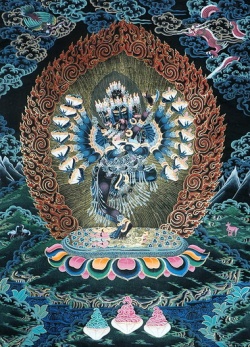Difference between revisions of "Emptiness in Theravada"
| Line 3: | Line 3: | ||
There is a general misunderstanding that "[[emptiness]]" is a [[Mahayana]] [[teaching]] only, and not found in [[Theravada Buddhism]]. | There is a general misunderstanding that "[[emptiness]]" is a [[Mahayana]] [[teaching]] only, and not found in [[Theravada Buddhism]]. | ||
| − | Mahavagga of [[Samyutta Nikaya]] the [[Buddha]] says: “[[Emptiness]] (sunnata) is what I teach. A [[teaching]] that does not treat of [[emptiness]] is someone else’s [[teaching]] composed by some later [[disciple]].” | + | [[Mahavagga]] of [[Samyutta Nikaya]] the [[Buddha]] says: “[[Emptiness]] ([[sunnata]]) is what I teach. A [[teaching]] that does not treat of [[emptiness]] is someone else’s [[teaching]] composed by some later [[disciple]].” |
| − | Pancaka Nipata, [[Anguttara Nikaya]] says: "A {{Wiki|discourse}} of any kind, though produced by a poet, or a learned man, versified, poetical, splendid, melodious in [[sound]] and syllable, is not an keeping with the [[teaching]] of the [[Buddha]] if not connected with [[emptiness]] (sunnata).” | + | Pancaka [[Nipata]], [[Anguttara Nikaya]] says: "A {{Wiki|discourse}} of any kind, though produced by a poet, or a learned man, versified, poetical, splendid, melodious in [[sound]] and {{Wiki|syllable}}, is not an keeping with the [[teaching]] of the [[Buddha]] if not connected with [[emptiness]] ([[sunnata]]).” |
Again the [[Buddha]] said: “And what [[bhikkhus]] is the [[path]] leading to the [[unconditioned]]? The [[emptiness]] [[concentration]]e [[signless]] [[concentration]]e undirected [[concentration]]s is called the [[path]] leading to the [[unconditioned]].” | Again the [[Buddha]] said: “And what [[bhikkhus]] is the [[path]] leading to the [[unconditioned]]? The [[emptiness]] [[concentration]]e [[signless]] [[concentration]]e undirected [[concentration]]s is called the [[path]] leading to the [[unconditioned]].” | ||
| − | “[[Thus]], [[bhikkhus]], I have taught you the [[unconditioned]]. Whatever should be done by a [[compassionate]] [[teacher]], out of [[compassion]] for his [[disciples]], [[desiring]] their welfare, I have done for you. These are the [[roots]] of [[trees]], [[bhikkhus]], these are the [[empty]] huts. [[Meditate]] [[bhikkhus]], do not be negligent, lest you [[regret]] it later. This is our instruction to you.” | + | “[[Thus]], [[bhikkhus]], I have [[taught]] you the [[unconditioned]]. Whatever should be done by a [[compassionate]] [[teacher]], out of [[compassion]] for his [[disciples]], [[desiring]] their {{Wiki|welfare}}, I have done for you. These are the [[roots]] of [[trees]], [[bhikkhus]], these are the [[empty]] huts. [[Meditate]] [[bhikkhus]], do not be negligent, lest you [[regret]] it later. This is our instruction to you.” |
| − | The [[world]] is sunnata, [[empty]]. | + | The [[world]] is [[sunnata]], [[empty]]. |
[[Khuddaka Nikaya]]: “Because of [[being]] [[empty]] of [[self]] or of things due to [[self]], it is consequently said that he [[world]] is [[empty]].” | [[Khuddaka Nikaya]]: “Because of [[being]] [[empty]] of [[self]] or of things due to [[self]], it is consequently said that he [[world]] is [[empty]].” | ||
| Line 19: | Line 19: | ||
[[Ajahn]] [[Buddhadasa]] of Suan Mokh said, “Don’t identify as ‘I’ or ‘mine’, act with clear [[awareness]] and there will be no [[suffering]].” | [[Ajahn]] [[Buddhadasa]] of Suan Mokh said, “Don’t identify as ‘I’ or ‘mine’, act with clear [[awareness]] and there will be no [[suffering]].” | ||
| − | “The sunnata of the [[Buddha]] means the absence of anything that we might have a right to [[grasp]] at and [[cling]] to as an abiding entity or self…The [[world]] is described as [[empty]] because there is [[nothing]] whatever that we might have a right to [[grasp]] at. We must cope with an [[empty]] [[world]], with a [[mind]] that does not [[cling]].” | + | “The [[sunnata]] of the [[Buddha]] means the absence of anything that we might have a right to [[grasp]] at and [[cling]] to as an abiding [[entity]] or self…The [[world]] is described as [[empty]] because there is [[nothing]] whatever that we might have a right to [[grasp]] at. We must cope with an [[empty]] [[world]], with a [[mind]] that does not [[cling]].” |
“[[Nothing]] to do. [[Nothing]] to be. [[Nothing]] to have.” | “[[Nothing]] to do. [[Nothing]] to be. [[Nothing]] to have.” | ||
| − | The [[Dhammapada]] 92 says: “The [[arahants]] have [[emptiness]] (sunnata) and signlessness as their [[object]]. | + | The [[Dhammapada]] 92 says: “The [[arahants]] have [[emptiness]] ([[sunnata]]) and signlessness as their [[object]]. |
Yasam sunnicayo [[natthi]] | Yasam sunnicayo [[natthi]] | ||
Ye parinnatabhojana | Ye parinnatabhojana | ||
| − | Sunnato animittoca | + | [[Sunnato]] animittoca |
| − | Vimokkho yasa gocaro | + | Vimokkho [[yasa]] gocaro |
Akase va sakuntanam | Akase va sakuntanam | ||
| − | Gati tesam durannaya | + | [[Gati]] tesam durannaya |
| − | They for whom there is no accumulation | + | They for whom there is no [[accumulation]] |
Who reflect well over their [[food]] | Who reflect well over their [[food]] | ||
Who have [[deliverance]] | Who have [[deliverance]] | ||
| Line 41: | Line 41: | ||
In [[Majjhima Nikaya]] 121, and also 122, the [[Buddha]] recommended a mode of [[perception]] that he called “entry into [[emptiness]]” in which one simply notes the presence or absence of [[phenomena]], without making any further assumption about them; to look at “[[experience]]” or “process” without assuming “[[essence]].” | In [[Majjhima Nikaya]] 121, and also 122, the [[Buddha]] recommended a mode of [[perception]] that he called “entry into [[emptiness]]” in which one simply notes the presence or absence of [[phenomena]], without making any further assumption about them; to look at “[[experience]]” or “process” without assuming “[[essence]].” | ||
| − | “This [[world]] is supported by a polarity, that of [[existence]] and nonexistence. But when one sees origination of the [[world]] as it actually is with right [[discernment]], ‘[[non-existence]]’ with reference to the [[world]] does not occur to one. | + | “This [[world]] is supported by a {{Wiki|polarity}}, that of [[existence]] and [[Wikipedia:Existence|nonexistence]]. But when one sees origination of the [[world]] as it actually is with right [[discernment]], ‘[[non-existence]]’ with reference to the [[world]] does not occur to one. |
| − | “The [[world]] is in bondage to attachments, [[clinging]] and baises. But one such as this does not get involved with or [[cling]] to these attachments, nor is he resolved on ‘myself.’ He has no uncertainty or [[doubt]] that mere [[stress]], when arising, is arising; [[stress]], when passing away, is passing away. In this, his [[knowledge]] is independent of others. It is to this extent that there is [[right view]].” [[Samyutta Nikaya]] XII 15 | + | “The [[world]] is in bondage to [[attachments]], [[clinging]] and baises. But one such as this does not get involved with or [[cling]] to these [[attachments]], nor is he resolved on ‘myself.’ He has no [[uncertainty]] or [[doubt]] that mere [[stress]], when [[arising]], is [[arising]]; [[stress]], when passing away, is passing away. In this, his [[knowledge]] is {{Wiki|independent}} of others. It is to this extent that there is [[right view]].” [[Samyutta Nikaya]] XII 15 |
</poem> | </poem> | ||
{{R}} | {{R}} | ||
Revision as of 13:56, 20 August 2014
There is a general misunderstanding that "emptiness" is a Mahayana teaching only, and not found in Theravada Buddhism.
Mahavagga of Samyutta Nikaya the Buddha says: “Emptiness (sunnata) is what I teach. A teaching that does not treat of emptiness is someone else’s teaching composed by some later disciple.”
Pancaka Nipata, Anguttara Nikaya says: "A discourse of any kind, though produced by a poet, or a learned man, versified, poetical, splendid, melodious in sound and syllable, is not an keeping with the teaching of the Buddha if not connected with emptiness (sunnata).”
Again the Buddha said: “And what bhikkhus is the path leading to the unconditioned? The emptiness concentratione signless concentratione undirected concentrations is called the path leading to the unconditioned.”
“Thus, bhikkhus, I have taught you the unconditioned. Whatever should be done by a compassionate teacher, out of compassion for his disciples, desiring their welfare, I have done for you. These are the roots of trees, bhikkhus, these are the empty huts. Meditate bhikkhus, do not be negligent, lest you regret it later. This is our instruction to you.”
The world is sunnata, empty.
Khuddaka Nikaya: “Because of being empty of self or of things due to self, it is consequently said that he world is empty.”
Emptiness means upekkha, equanimity, void of lusts, which Buddha emphasized.
Ajahn Buddhadasa of Suan Mokh said, “Don’t identify as ‘I’ or ‘mine’, act with clear awareness and there will be no suffering.”
“The sunnata of the Buddha means the absence of anything that we might have a right to grasp at and cling to as an abiding entity or self…The world is described as empty because there is nothing whatever that we might have a right to grasp at. We must cope with an empty world, with a mind that does not cling.”
“Nothing to do. Nothing to be. Nothing to have.”
The Dhammapada 92 says: “The arahants have emptiness (sunnata) and signlessness as their object.
Yasam sunnicayo natthi
Ye parinnatabhojana
Sunnato animittoca
Vimokkho yasa gocaro
Akase va sakuntanam
Gati tesam durannaya
They for whom there is no accumulation
Who reflect well over their food
Who have deliverance
Which is void and signless as their object…
Their course like that of birds in the air
Cannot be traced.
In Majjhima Nikaya 121, and also 122, the Buddha recommended a mode of perception that he called “entry into emptiness” in which one simply notes the presence or absence of phenomena, without making any further assumption about them; to look at “experience” or “process” without assuming “essence.”
“This world is supported by a polarity, that of existence and nonexistence. But when one sees origination of the world as it actually is with right discernment, ‘non-existence’ with reference to the world does not occur to one.
“The world is in bondage to attachments, clinging and baises. But one such as this does not get involved with or cling to these attachments, nor is he resolved on ‘myself.’ He has no uncertainty or doubt that mere stress, when arising, is arising; stress, when passing away, is passing away. In this, his knowledge is independent of others. It is to this extent that there is right view.” Samyutta Nikaya XII 15

